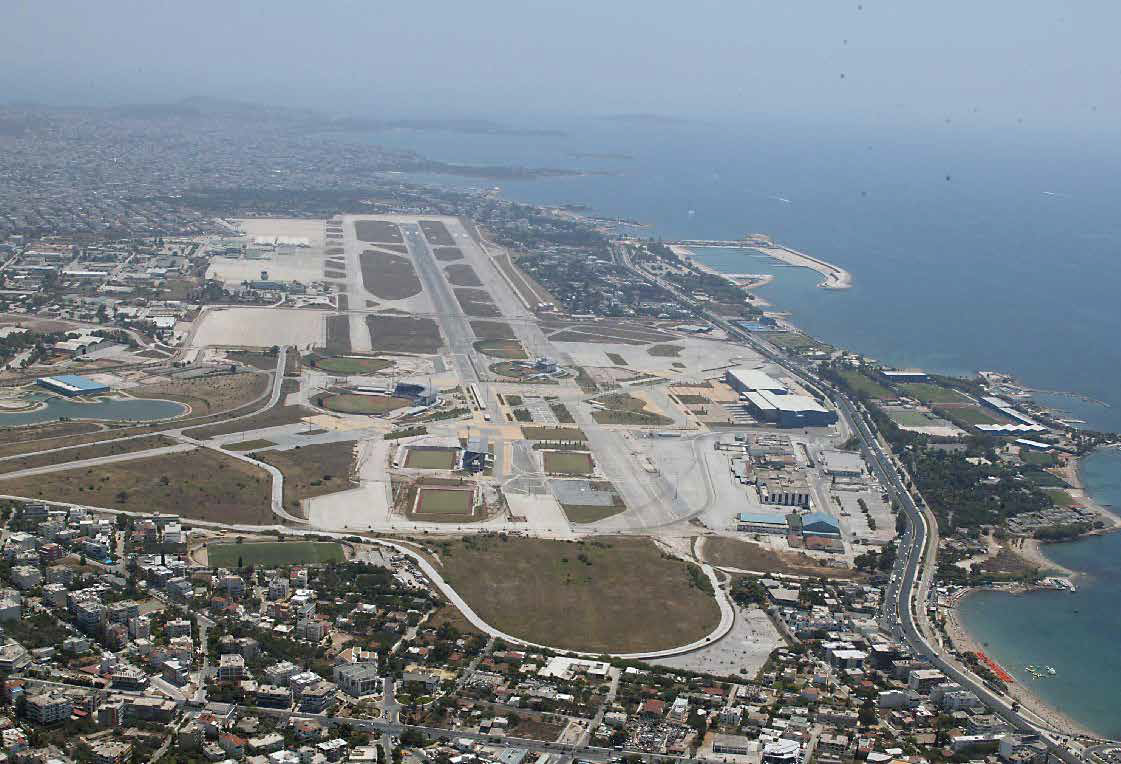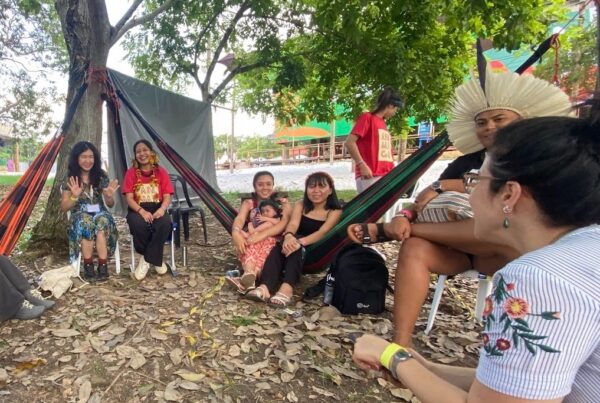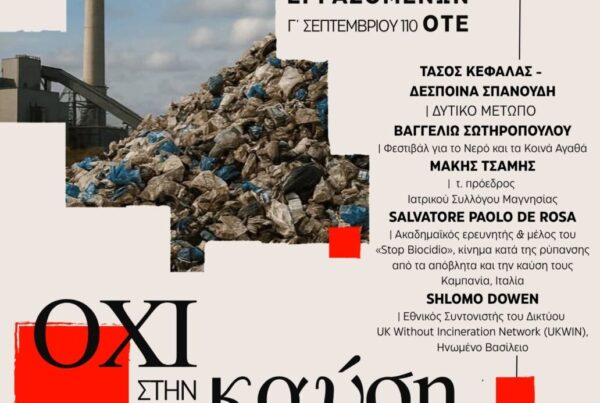What will happen in the area of the former Hellenikon airport and the coast of Ag. Kosmas is not only an issue that concerns the inhabitants of the neighboring municipalities. It transgresses locality – affecting all citizens of Athens – and it questions environmental justice in the city, the access to green and blue amenities, and the sale-out and privatization of common goods.

The former airport of Hellinikon and the coastal front of Ag.Kosmas, Athens
Communication from the initiative “A Park for all in Hellenikon”
The case of Hellenikon appears to be “done and dusted”. The contract has already been signed between the Greek State and the so-called investors. The Integrated Development Plan (IDP), which describes the overall development project (including new urbanization, tourist attractions, hotels, casino, conference centre, and a so-called Metropolitan Park), was filed last August (!) 2017. Within the prohibitively short time-frame of 20 days, the statutory consultation process with social actors and citizens was concluded.
The promises and hopes of Hellenikon turning into a new, ample and public green amenity have slowly mutated into obligations towards creditors, job creation fantasies, and most of all, profit-making opportunities for constructors and investors.
But how many know exactly what the “IDP” foresees for Hellenikon? What are the envisioned land uses, the planned works and constructions? How many are aware of the environmental and social impacts that the operation of this new urban complex will have in the wider region?
What will happen in the area of the former Hellenic airport and the coastal zone of Ag. Kosmas is not only an issue that concerns the inhabitants of the neighboring municipalities. It is an issue that transgresses locality, affecting all citizens of Athens as it is closely connected to its overall urban and environmental planning. More importantly, it is an issue of environmental justice, access to green and blue amenities, and the sale-out and privatization of common goods.

Source: Agonas Kritis
A bit of recent history about Hellenikon
The socio-environmental conflict on the sale and development of what used to be Athens main airport in the southern coastal zone of Attica, until 2001, is not an unknown story. In an effort to bring to light a number of cases from Greece on environmental conflicts and social movements, Giorgos Velegrakis and Ermioni Frezouli have included a brief history of the Hellenikon case up until 2016 (see here, in the wider framework of the EJ Atlas project, documenting and describing environmental conflicts worldwide).
The idea of creating a metropolitan park in the area came about in 1995, following the ratification of the contract for the construction and operation of a new airport at Spata in eastern Attica (El. Venizelos airport). In 1996 a research project on the creation of the park started. However, in 1997 Greece undertook the organization of the Olympic Games for 2004, and this project was never completed. Instead, several sport facilities were created in the territory of the ex-airport. Governments at the time promised a provisional character of the buildings, as the area eventually would be turned into a park.
Nevertheless, in December 2003, the Ministry of Environment, Spatial Planning and Public Works (now renamed to Ministry of Environment, Energy and Climate Change, YPEKA) launched an international architectural competition for the creation of a metropolitan park as well as the development of the area, comprising business buildings, residences, restaurants, etc. In 2007 the Minister presented a proposal for the area with malls and residences of 130 ha. At that time, the 4 municipalities adjoined to the former airport (Alimos, Hellinikon, Argyroupoli, Glyfada) started coordinated action in order to stop the privatization and development of the area and asked for a park, as the first plans had foreseen.
The Urban Environment Laboratory, School of Architecture, NTUA, was assigned the elaboration of a research project entitled “Basic plan principles for a Metropolitan Park at the former airport of Hellenikon”, which was presented in 2011, documenting the reasons why a metropolitan park is needed for the wider area of Athens. The project described in detail the creation of a park that would be technically and financially feasible.
The financial crisis and the memorandum by the Troika brought new legislation for the privatization of commons and the area of the airport was comprised in this process in order to attract investments towards Greece. Following that, in March 2011, a broad civil society movement (named Struggle Committee for the Metropolitan Park) from all over the Attica region was formulated, fighting for the creation of a metropolitan park. Many activities, such as tree planting, concerts, festivals, discussions, took place in the area of the former airport, demonstrating the willingness of the residents to have a green park. Civil society groups have been using the existing premises of the former airport for social activities, hosting, for example, the most successful social health center, the “Metropolitan Community Clinic at Helliniko” and the Initiative for a self-organized agricultural field in Hellenikon.

Ιn February 2012, YPEKA approves a law for Hellinikon, which creates a flexible framework of building regulations and land uses (it increases the built-surface ratio, allows construction on coastal zone and allows major landscape interventions, including golf courses), as well as introducing flexibility in the procedures for the implementation of the investment plan.
In June 2012, residents from the municipalities close to Hellenikon file an action before the Council of State against the Joined Ministerial Decision with which the former airport was granted to Hellenic Republic Asset Development Fund (TAIPED), in order to sell it to private investors. Another action was filed before the Council of State against the Joined Ministerial Decision with which the coastal zone and the sport facilities were given to TAIPED.
In February 2014, only one offer was submitted by Lamda Development S.A., a Greek company which, having ameliorated its first offer, signed the contract for the development in November that year. In October 2014, the Technical Chamber of Greece underlined that the nominal value for the whole area was $34,184,617,255, and not $1.1 million, which is the amount that Lamda Development S.A. has to grant. The contract has to be ratified by the Greek parliament and the Court of Auditors’ ruling is not yet publicized.

Source: This is city life
An open letter: an effort to inform and a call for action
The case of Hellenikon is now at a critical point. The process of the so-called “consultation” has concluded and the Presidential decree about the development plan is awaiting approval by the Court of Auditors. In this context, the initiative “A Park for all in Hellinikon” considers important to give the maximum visibility to some key points that characterize the plan for Hellenikon, some of which include:
- A new city with a population of approximately 25-35,000 inhabitants and with features of private urban planning is planned for the area of Hellenikon.
- 6,204 acres, including the Ag. Kosmas coastal area, the Olympic Sailing Center marina and all the Olympic facilities, are all handed over to investors.
- At least 2,700,000 square meters are planned to be urbanized (dwellings, shopping malls, office buildings, exhibition and congress facilities, recreation facilities, etc.), while the total statutory building (according to project-specific legislation) is up to 3,600,000 square meters.
- Plans foresee dozens of 50 and 70-meter blocks of flats and 6 skyscrapers that go up to 200 meters (65 floors) high.
- The existing free access green zones of the coastal belt will be removed, as well as the existing groves of Ag. Kosmas and Ag. Alexandros, and the surrounding forest area of the Civil Aviation Service, among others.
- What is described as a park in the investment project is surrounded by multi-storey houses of 50 and 70 meters high, forming essentially the “inner yard” of luxurious blocks of flats.
- Of the provisioned 200 ha of the so-called “Park”, 42,5 ha (21%) will be used for the Exhibition Center, 52,5 ha (26%) for sports uses, a residential skyscraper as well as the transfer of part of St. Kosmas’ sports facilities.
- If such incompatible uses are not counted, the so-called “Park” is essentially limited to 65 ha (32%).
- Most of the new coastal front is planned to be of restricted or blocked access
- The National Athletic Center of Ag. Kosmas will be substituted by a complex of luxurious detached houses
On the basis of this reality, an alternative proposal was developed by the initiative “A Park for all in Hellinikon” (see here and here). This considers possible the formulation of an alternative model of social reappropriation and shared management of the ex-airport of Hellenikon and the St. Kosmas Coastal Zone by social organizations and collectives, in the form of cooperatives and in the context of the social and solidarity economy, as opposed to privatization, further grey infrastructure development and environmental degradation.
This proposal is under open deliberation process by citizens movements, awaiting further developments.
Contact: [email protected]






Reblogged this on Political Ecology Network.